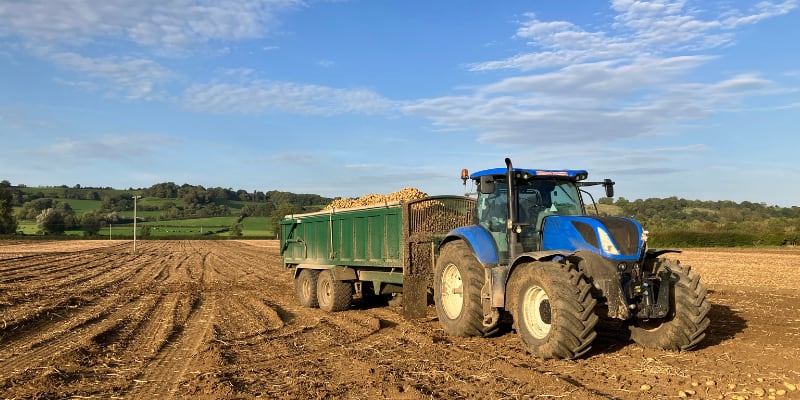Moving material safely: Are your workers at risk?

Tragic incidents involving the improper handling of materials in Ontario’s agriculture sector have led to fatal outcomes. One worker was fatally crushed by a concrete block during lowering, another was struck by a tractor, and a third was hit by equipment on a trailer.
When the Ministry of Labour, Immigration, Training and Skills Development (MLITSD) focused their attention on safe material handling in Ontario’s agriculture sector last year, the goal was to help prevent incidents like the ones mentioned above. Inspectors were mainly looking at three things: how agriculture workers move things manually, how they use equipment to move things, and how things are stored.
“Essentially, Ministry inspectors were looking at the movement of equipment and material to ensure that it is being done safely,” says Kristin Hoffman, Health and Safety Consultant with Workplace Safety & Prevention Services (WSPS). “When we talk about transporting material, we’re talking about everything from how workers push greenhouse carts, use a front-end loader to move concrete blocks, and how they stack bags of fertilizer for storage,” she explains.
Manual versus Mechanical
Each day, farm workers manually push, pull, lift, and carry things of all shapes and sizes to keep the operation running. Over time, they often suffer from injuries to their muscles, joints, tendons, and ligaments (e.g., back or shoulder injuries). Collectively, these types of injuries are called musculoskeletal disorders (MSDs). If not addressed, they can lead to long-term pain and reduced mobility that can significantly impact their quality of life.
Equipment such as forklifts and tractors, can reduce the risk of injuries to muscles and joints by eliminating the manual lifting, pushing, pulling, etc. “Using mechanical equipment to move material is a great way to eliminate the strain on your body and reduce the risk of developing an MSD, but it can also lead to critical injuries or fatalities if the proper training and procedures are not in place,” warns Kristin.
Conveyors, augers, and tractors are also examples of mechanical equipment commonly found on farms. There’s no doubt that they help to increase productivity, reduce the risk of injury from repetitive movements, and make it easier to get work done. However, they also introduce new hazards to the workplace. If a farm worker gets caught in an auger, pulled into a conveyor, or run over by a tractor, it will likely result in a critical injury or fatality. “The hazards associated with mechanical equipment often lead to more severe injuries,” says Kristin. “However, effective training, planning, and documented procedures can mitigate the risk.”
Get started with these 6 tips
Farm owners and operators are required by law to inform workers of the hazards they will face on the job. They are also required to take every reasonable precaution to protect their workers. Kristin offers this advice to help you protect yourself, your family, and your workers from serious injury.
- Start with a hazard assessment. Go through each task and think about the hazards associated with each step. Then, identify what you will do to minimize the risk. For example, if you are using a tractor to move hay bales, consider the operator’s sightlines and blind spots. Are there workers at risk of not being seen? Another example is when you are using a conveyor to move products. Are there pinch points that could catch a worker? Once you have identified the hazards and controls, use this information to create a safe work procedure for each task.
- Provide training. Everyone who works with mechanical farm equipment needs to be trained to operate it safely. They also need to understand the hazards associated with it. Once you have established a safe work procedure, train workers. Then, observe them using the equipment to ensure they understand how to do it safely. “Even those who may not operate a forklift or a tractor should have a clear understanding of the hazards and know where the operator’s blind spots are,” says Kristin.
- Always use machine guards. Doing so will help to prevent workers from getting caught in pinch points, which can lead to serious injuries. Training should include which guards are for which equipment, how to use them, and how to recognize when they are not properly installed.
- Do not overload storage systems. When using racking or other storage systems, make sure to follow capacity guidelines to avoid collapsing racks. Provide training on how to safely stack and secure items to minimize the risk of something falling on a worker.
- Stay on top of preventative maintenance. Avoid surprises by scheduling and conducting regular inspections of equipment, machines, and racking to ensure everything is in good working order (e.g., stability of shelving units, safety features on equipment, etc.).
- Stretch, rotate jobs and adjust the work area. Teach farm workers how to prevent muscle and joint injuries by stretching regularly and lifting properly. Break up repetitive jobs by rotating tasks to avoid straining a specific part of the body (e.g., back, knees). Design the work area to minimize bending, reaching, crouching, etc.
How WSPS can help
Consulting
WSPS’s agriculture health and safety experts can help you improve your health and safety program, address material handling hazards, and prevent injuries in your workplace.
Training
- JHSC Certification Training – Part 2 Agriculture (online instructor-led, 2 days)
- Health & Safety Awareness Sessions (instructor-led, 1-2 hours)
- Tractor Safety Training (eCourse, 1 hr)
- Manual Material Handling Training (eCourse, 1 hr)
- Inspecting and Maintaining Steel Storage Racks Training (online instructor-led, 1 day)
Resources
- Agriculture Safety Resources in Multiple Languages
- Material Handling Resources in Multiple Languages
- Machine Safeguarding Poster
- Health and Safety Orientation Handbook Generator
- Farm Safety Roundup (podcast)
The information in this article is accurate as of its publication date.




